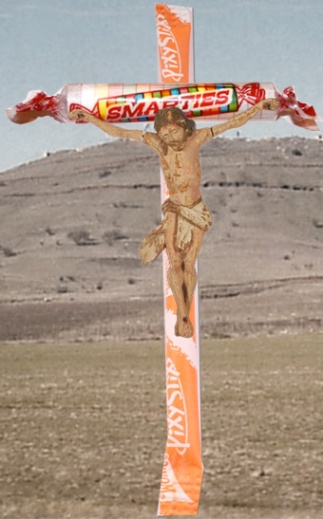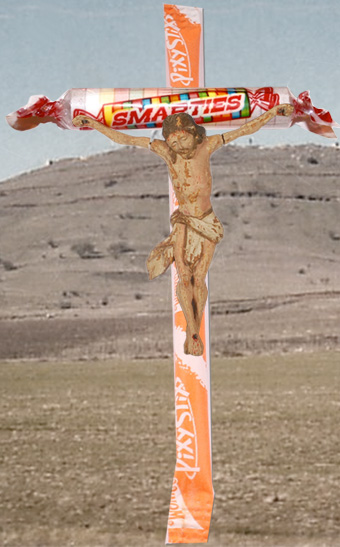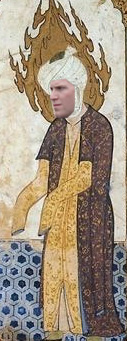Clarification About Arjuna, Krishna, and Coca Cola – Now With A Crucifix Of Candy

A while back, the Ithaca Myth blog published an article with the title, Arjuna and Krishna Have A Coke And A Smile.
 The article featured the graphic you see here, with Krishna and Arjuna drinking Coca-Cola instead of blowing conch shells to begin a battle against Arjuna’s cousins.
The article featured the graphic you see here, with Krishna and Arjuna drinking Coca-Cola instead of blowing conch shells to begin a battle against Arjuna’s cousins.
The article was intended to begin a discussion. The text accompanying the picture read: “How would the Baghavad Gita have been different if Arjuna and Krishna, instead of blowing on their conch shells, took a long drink of Coca-Cola? That’s the scenario that this mythological mashup imagines. Is it appropriate, or not? Why do you think so?“
The reactions to this very brief article have been extreme.
Some have suggested that the Ithaca Myth blog intends to pick on Hindus, while sparing iconography of other religions from similar mashups with popular commercial imagery. There never was any intent to target Hinduism exclusively. The purpose of the combination of popular religious imagery and popular commercial imagery was to provoke discussion about the similarities and differences between the two cultural categories. One Hindu writes, for example, “This is dirty gimmick and cheap work. don’t you think that this hurts sentiments of Hindus?, Do you dare to give a coke bottle to Jesus or Prophet?”
In order to dispel the notion that Hinduism was meant to be singled out in any way, we now offer up a similar image, but this time altering the Christian holy image of the crucifix, placing pieces of Halloween candy where the wooden beams of the cross are supposed to be.

Other comments have demanded that the picture be censored and threatened legal actions if the image is not withdrawn. Such pro-censorship comments include:
“you can be booked for this image. Pay some respect for religious values and emotions”
“Warning : Delete this photo in 48 hours, this make Shame of Hinduism, otherwise we will take legal action on you.
(Hindu Nayay Petth)”
No legal action has been taken, of course, because there is nothing illegal about the picture. We have freedom of speech in the United States, which includes the right to satirical representations, even of copyrighted works.
Another set of comments by Hindus has threatened physical violence against the creator of the mashup image:
“How would it be if all Krishna devotees beat you like a dog…. Be in your limits…”
“these people should be hanged”
“How would it be different if somebody rapes your mother in a open street.”
That these threats do not reflect well upon Hindus is, I hope, obvious.
Another set of comments have suggested an activist campaign directed against Coca-Cola, under the belief that the image was created by Coca-Cola and used in an advertisement for Coke. “Hello every Hindhu,” writes Shiva, “let’s stop drinking coke. Please please please take it as a oath and follow it. Let’s teach them a lesson.”
In fact, Coca-Cola neither created this image nor endorses it. The image is not used in any advertisement for Coke.
It’s worth noting that the the instinct of anxiety and outrage is strong in all manner of religious communities – not a unique trait of Hinduism. Christians have demanded that images of Jesus smoking a cigarette be banned. Muslims have engaged in violent protests in reaction to cartoons of Mohammed.
In the context of this specific image, there were members of the First Unitarian Society of Ithaca who were outraged that a discussion series at the organization was being promoted through a web site at all. The idea of putting the discussion of religious ideas online at all was enough to send some members of that religious group into a tizzy – as if there was something morally polluted about the Internet itself.
The point is that it’s quite difficult to have any open and honest discussion of religion at all these days without someone getting upset about it. When religious beliefs are formed in insulated communities, it can be shocking for members of those communities to realize that their own assumptions are not regarded reverentially by everybody else in the world.
Yet, religious pluralism is increasing everywhere around the world – in India as well as in the United States. We all will have to get used to seeing our own cherished symbols reconstituted by others into forms that we regard as profane. One person’s profanity is another person’s sacred insight, and there is no single authority that has the right to declare what must be done and what must not be done with religious symbols.
To demand that a particular religious symbol be only presented in a single manner is to treat it as the exclusive property of just one group. If we were to go down that road, only the most insipid art could be produced: Watercolors of kittens perhaps would remain tolerable.
We live in a world where cultures meet and mix. The sacred images, words and ideas of one culture will be encountered by other cultures, and picked up, and used.
Is this a problem?
The use of religious imagery will offend some. It will bother even more.
Should, then religious imagery be off-limits in art, and for satire? Should mashups be banned?
One problem with the censorship approach is that it presumes that there exists a single central authority that is capable of approving or disapproving all images for any given religion. Who shall that be? Will the Pope be given the power to decide what is censored for all of Christianity, even though he only has authority over Catholics, and not protestants? Who gets to decide what kinds of Muslim imagery will be allowed – the Sunnis or the Shiites? Is there one person or one group within Hinduism or Buddhism that has the power to decide which pictures should be banned for all Hindus or Buddhists?
Beyond this simple political problem, there’s a cross-cultural problem. Who gives Hindus the authority to decide what everyone else in the world can do and cannot do? What gives Christians the right to demand that Jesus be depicted only in some ways? Since when do Muslims have the power to stop other people from drawing pictures of Mohammed?
Where would this leave atheists? Would they have to obey everyone else’s religious laws, even though they believe in no religions at all?
In a world where everybody else has to obey the taboos of other people’s religions, nobody has freedom of speech, and nobody has freedom of religion.
What’s to stop a group of Californians from declaring that they have formed a new religion, which believes that pictures of children should never appear in advertisements? Would everybody have to obey this new religious rule?
Where would this new standard for universal observation of religious laws end? Would non-Hindus be banned from eating beef? Would non-Muslims no longer be able to eat pork? Would non-Jews have to observe Kosher laws? Would everybody have to eat fish on Fridays during Lent, just because that’s what Catholics do?
A far easier solution is to embrace cultural diversity, and show respect for freedom. Free speech sometimes makes people angry, or feel disrespected, but the alternative is far, far worse.
POSTSCRIPT: A Hindu reader now responds that we ought to be showing an image of Mohammed that will offend Muslims, too. All right, here’s a picture of Mohammed with a face. Many Muslims object strongly to this kind of thing.
What’s next? Is someone going to demand that I step on an ant in order to offend Jains?

